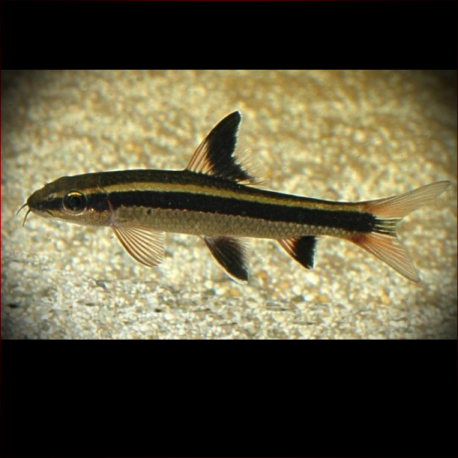More info
Datasheet
| Minimum Tank Size | 240 litres / 63.40 US gallons |
| Maximum Size | 16.0cm / 6.30inches |
| Temperature | 20°C / 68.00°F - 26°C / 78.80°F |
| Hardness | 2.02dgH / 36ppm - 12.05dgH / 215ppm |
| pH | 6.0-7.5 |
General Description
The Epalzeorhynchos Kalopterum, commonly known as the Flying Fox, is a fish species belonging to the Cyprinidae family. This species was previously referred to as E. kalopterus until a correction in nomenclature was made. It is known for its unique white-edged, red, and black fins and the presence of two pairs of barbels. The fish can reach a maximum size of 16.0cm and is typically found grazing on sandy or rocky substrates in streams and rivers.
Aquarium Setup
When setting up an aquarium for the Flying Fox, it is recommended to provide sufficient cover to resemble a flowing river environment. The tank should have a substrate of variably-sized rocks, gravel, and water-worn boulders. Adding driftwood roots, branches, and plants like Microsorum, Bolbitis, or Anubias can enhance the natural habitat. Bright lighting to promote algae growth, which the fish grazes on, is beneficial. The species prefers high dissolved oxygen levels and moderate water movement. Detailed water conditions include a hardness of 36-215ppm, pH range of 6.0-7.5, and temperature between 20-26°C (see table).
Behaviour
The Flying Fox can be territorial and aggressive towards similar-looking species as it matures. It is advisable to introduce tank mates carefully, preferably robust, active, schooling cyprinids for the upper levels. The fish may display alliances with certain species like Chromobotia macracanthus. While some individuals may be more belligerent, others may exhibit different behavior. Generally, maintaining Flying Foxes singly is recommended, especially in smaller tanks, to prevent territorial disputes.
Feeding and Diet
As an aufwuchs grazer, the Flying Fox primarily feeds on algae, small crustaceans, and insect larvae. Offering a varied diet, including live and frozen foods such as chironomid larvae, Daphnia, Artemia, along with quality dried flakes, granules, and plant material, helps in maintaining optimal health and colors. Additionally, providing shelled peas, cucumber, spinach, and fruits can be beneficial. The fish tends to browse on biofilm that forms on solid surfaces and may ascend into midwater to feed once settled in the aquarium.
Reproduction & Dimorphism
Reproduction of the Flying Fox in private aquaria is rare, but commercial farming is done with the use of hormones. Sexually mature females are generally thicker-bodied compared to males, aiding in distinguishing between the sexes. However, accurately sexing juveniles is challenging. The fish likely exhibits solitary behavior in the wild, with interactions mostly occurring during the spawning season.
Habitat and Distribution
The Flying Fox is primarily found in southern Thailand, Peninsular Malaysia, and the Greater Sunda Islands such as Borneo, Sumatra, and Java. The fish inhabits sandy or rocky substrates in streams and rivers, migrating to inundated floodplains or forested areas during the wet season. Due to human developments affecting its migratory patterns, populations have dwindled, and wild-caught specimens are seldom available in the ornamental trade.
Etymology
The genus name Epalzeorhynchos possibly refers to a cone-shaped protuberance on the fish's snout or means "curative." The species name Kalopterum stems from the Ancient Greek words for "beautiful, lovely" and "feather, wing," hinting towards the attractive nature of the fish's fins.

